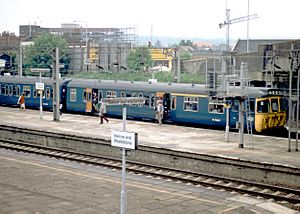British Rail Class 310 facts for kids
Quick facts for kids British Rail Class 310 |
|
|---|---|

Class 310 train in British Railways plain blue calls at Harrow and Wealdstone station. The driving cab features wrap-around windows as originally fitted to these trains.
|
|
| In service | 1966 - 2004 |
| Manufacturer | British Rail C&W Works Derby |
| Number built | 74? |
| Formation | 3/4 cars per trainset |
| Operator(s) | British Rail |
| Specifications | |
| Maximum speed | 75mph (121km/h) |
| Weight | Total - 158 tonnes |
| Braking system(s) | Air (auto/EP) |
| Track gauge | Standard gauge (1,435 mm) |
The British Rail Class 310 was a special type of train used in the United Kingdom. It was an electric multiple unit (EMU), which means it was a train powered by electricity, and its engines were spread out across different carriages. These trains were known for their "slam-doors," which were common on older British trains.
The Class 310 trains were first introduced in 1966. They were a key part of a big project to make the West Coast Main Line electric. This line is a very important railway route in Britain. Before they were called Class 310, these trains had a different name: Class AM10. This changed when a new system called TOPS was brought in to classify trains.
What is the Class 310 Train?
The Class 310 trains were built by British Rail at their Derby Carriage and Wagon Works. Each train usually had four carriages. These carriages had different purposes:
- One was a second-class driving trailer. This means it was at the end of the train and had a driver's cab, but no engine.
- Another was a second-class trailer, which was just for passengers.
- There was also a second-class motor car. This carriage had the train's electric motors. It also had a special area for the guard and luggage. The pantograph, which collects electricity from overhead wires, was on top of this car.
- The last carriage was a composite driving trailer. This carriage had both first-class and second-class seats, and it also had a driver's cab.
Key Features of the Class 310
These trains could travel at a maximum speed of 75 miles per hour (about 121 kilometers per hour). One cool feature of the Class 310 was a glass wall right behind the driver's cab. This allowed passengers in the front and back carriages to have an amazing view of the railway line as the train moved. Imagine seeing the tracks disappear behind you or stretch out in front!
The Class 310 trains were used for many years, from 1966 until 2004. They played an important role in connecting towns and cities along the West Coast Main Line.
Images for kids
-
The V Train on the DC system pictured in the New Sidings at Ramsgate - the Class 423 (4-VEP) is the second vehicle.
-
The V Train on the AC system pictured near Shenfield railway station on 2 February 2004 - the train consists entirely of Class 310 vehicles



